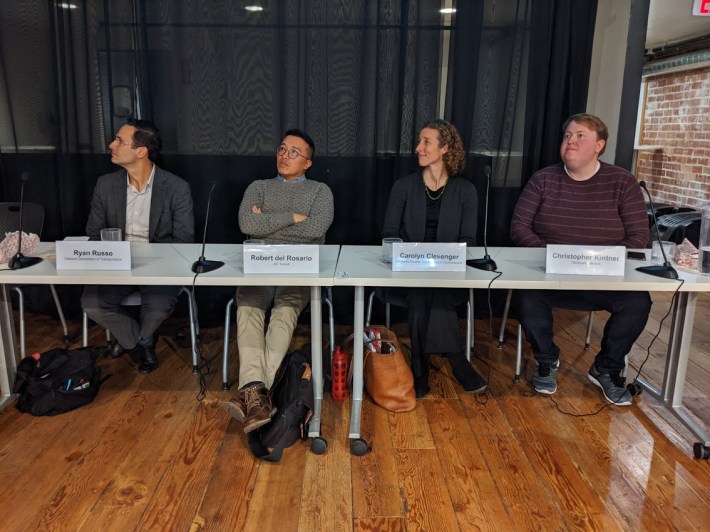Between the environmental studies, the outreach, the engineering, and the construction, it's taken since 1997 to get 7.6 miles of dedicated transit lane (also known as 'Bus Rapid Transit') on International Boulevard in Oakland. "We’re at the very, very end" of the $240 million project, said AC Transit's Robert del Rosario, adding that it should be open in May of this year, although he cautioned that heavy rains could push that back.
The fact that it took so long to install just eight miles of dedicated bus lane illustrates the challenges of making dramatic improvements to bus service and clawing back space from the automobile for exclusive transit use. That was one of the many threads explored at "Planning Transit-Only Lanes in Oakland," a talk at SPUR's Oakland location.
"I have a lot of scars from bus lanes battles in NY and it's 'Select Bus' program," said Ryan Russo, formerly with New York's Department of Transportation, and now head of Oakland's. "But there were a lot of lessons... one of the biggest lessons was the role of advocacy."
Russo points out that there are strong advocacy groups in the Bay Area for better bike infrastructure, and for pedestrian safety--but advocacy for bus riders tends to be more scattershot. "I don’t get angry emails about the slow bus," he said. "But I getting lots of angry emails about a pothole or speeding traffic."
That's something Christopher Kintner of the advocacy group Transport Oakland is working on. But first, he said, Oakland and Alameda County need to acknowledge the structural problems that make most bus service unreliable and infrequent. "We need to know where we’re at," he said, adding that one of the biggest problems is that nearly ten percent of scheduled buses don't even show up. AC Transit, he said, just doesn't have enough operators to cover all the runs on the schedule.
Del Rosario explained they want to hire more drivers, but their budget doesn't allow it. So when a bus driver calls in sick, "we don’t have a backup," he explained.

The lack of bus drivers is further exacerbated by ever increasing congestion on the streets, which lowers bus speeds. Del Rosario showed a chart indicating that average bus speeds in 2009 were nearly 13 mph, but it's 11 mph today. He added that the chart showed scheduled speeds; "Actual transit speeds are slower," he said. That means they need more operators just to maintain service frequencies, since each operator takes longer to complete a run.
Not surprisingly, AC Transit has seen a concurrent loss of riders.
The key to reversing these trends, said the panelists, is to give buses the means to bypass traffic. Obviously, that makes riding the bus more attractive on its own. And if buses go faster with end-to-end run times that don't vary wildly depending on traffic, each operator can be assigned more runs, and fewer are needed to provide the same service frequencies.
Sometimes it doesn't even require something as big as a bus-only lane. "We can talk about bus lanes, but just giving buses priority, and keeping the bus moving," can go a long way towards accomplishing that goal, explained Russo. He mentioned the quick-build boarding islands Oakland installed on Telegraph. "Just keeping the bus from having to enter and exit traffic at every stop... keeps the bus on Telegraph moving."

Russo said they will be incorporating boarding islands into future projects. By using modular, quick-build installations, substantial improvements can be made in transit service times and frequencies without long construction timelines.
One of those projects that may be approached in a more stop-gap, quick-build approach is San Pablo Avenue, slated for major upgrades to its bus service. However, as with other streets, everything becomes a trade-off between motoring, transit, bike, and neighborhood issues. "San Pablo serves a number of different uses--it is a bus corridor, but it is also a commercial corridor," explained Carolyn Clevenger of the Alameda County Transportation Commission. "One block off and you’re in residential neighborhoods and you have to think about where cars might be diverted." The county is looking at options for protected bike lanes and center-running bus lanes, or side-running bus lanes--but in either case neighbors and businesses are pushing back about the loss of parking. "Parking and loading is a huge issue on this corridor; there aren't alleys to do loading" behind the shops, she said.
Del Rosario, however, said the debate shouldn't be about a trade-off between protected bike lanes and dedicated transit lanes. Instead, it should be a trade-off between automobile uses: "How many [automobile] travel lanes do you want? Do we have one lane of travel and maintain the parking? Or do we have two lanes of travel and lose the parking?"
That, in fact, was a common theme at the discussion--with ever increasing traffic, pollution, greenhouse gas emissions, and collisions, the priority has to start being the transit rider, not drivers of private automobiles. Del Rosario even encouraged people to talk about "the big red elephant in the room: a Bay Bridge bus lane."
And Russo mentioned some have even started asking about a car-free Broadway.
Meanwhile, the panelists said they were looking forward to the opening of the Oakland BRT project, which will have "new buses, with five doors with left-side and right side loading," said del Rosario, to allow them to take advantage of pre-paid boarding and center boarding islands. That project, they hope, will raise the bar for what bus service can be throughout Oakland.
"I'm hoping that 2020 can be the year of the bus," said Russo.
For more events like these, visit SPUR’s events page.





